Paint me like one of your cypress trees
Van Gogh's cypresses: the art of obsession and the obsession of art
I have a friend, a cultural devotee of sorts, who finds solace in the hallowed halls of the Metropolitan Museum of Art so often that if she's missing after work, the Met is where you'd send a search party. Every now and then, she generously allows others into her sacred routine, and on one such occasion in the bloom of May, I found myself the lucky interloper.
As we meandered through the museum, we stumbled upon a preview for the Van Gogh's Cypresses exhibition. I'll admit, I initially assumed it might be one of those light installation exhibits best savored with a side of whimsy, or perhaps a little less sobriety. I wasn't exactly brimming with excitement; I had come to the museum for physical original art, not light projections or AI-generated work. Furthermore, I was feeling serious and sober.
But oh, how glad I am to have braved the long lines, for witnessing Van Gogh's artwork in person is not merely viewing recognizable art —it's an encounter. It's an obsession in the making, compelling enough to make one brave the bustling crowds for a return engagement with those enigmatic cypress trees.
I write about Van Gogh's Cypresses for two reasons.
First, this no-cost ticket to nineteenth-century Provence is closing this Sunday. Run, don't walk, to see it at least once, if not twice.
Secondly, and perhaps more personally intriguing, I find myself in the peculiar position of being obsessed with the quest for obsession itself.
Van Gogh and the Cypresses
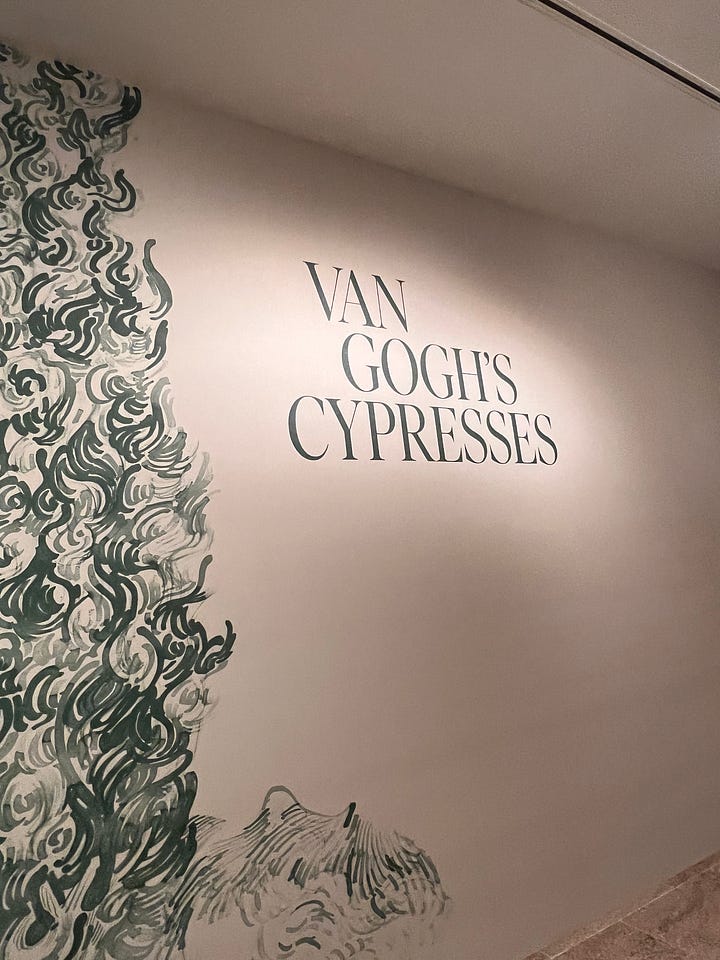
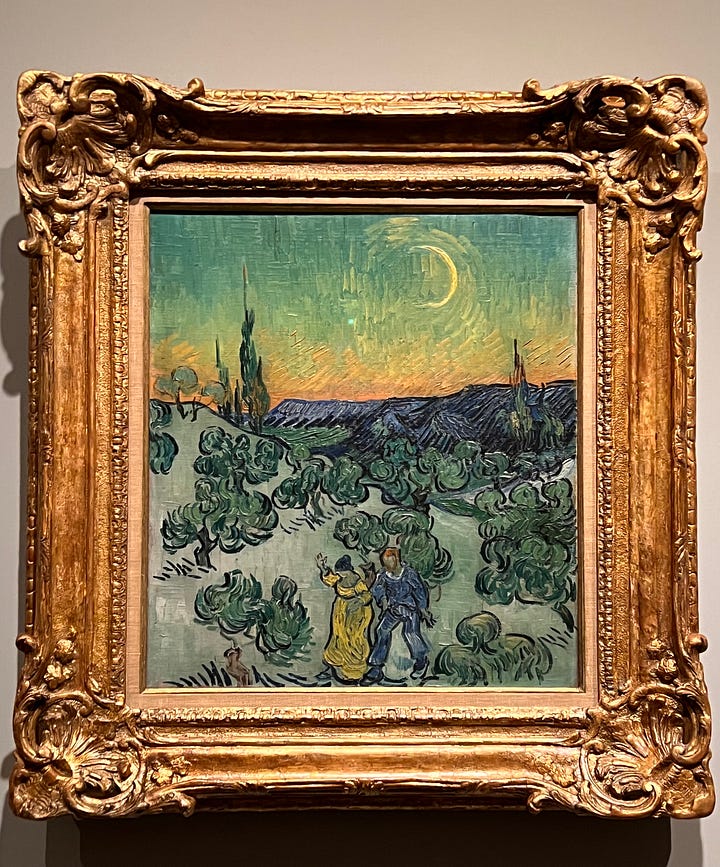
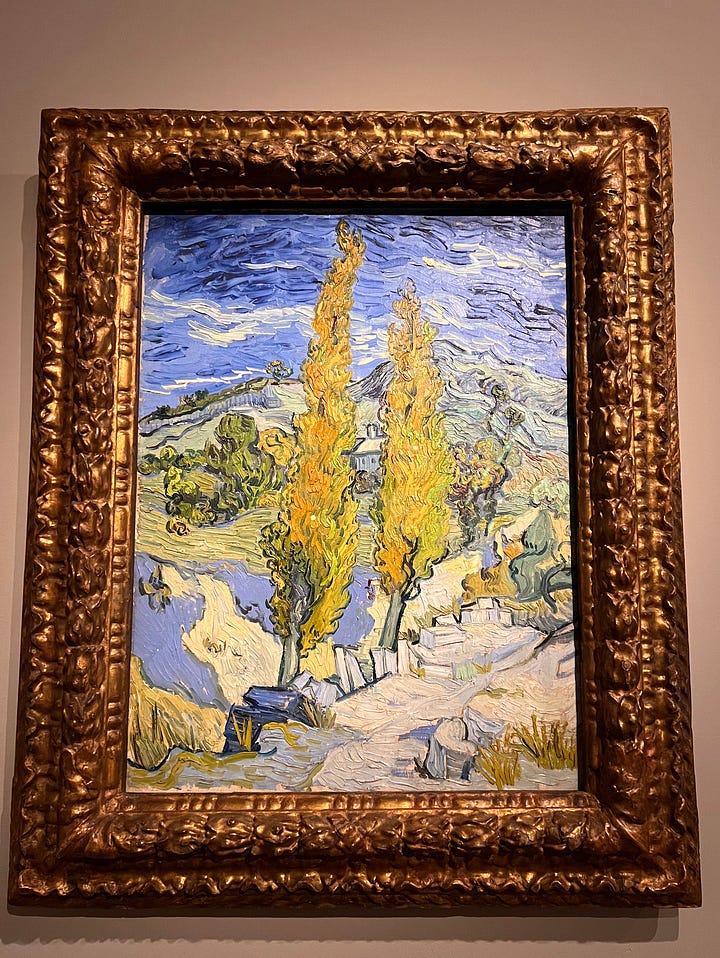
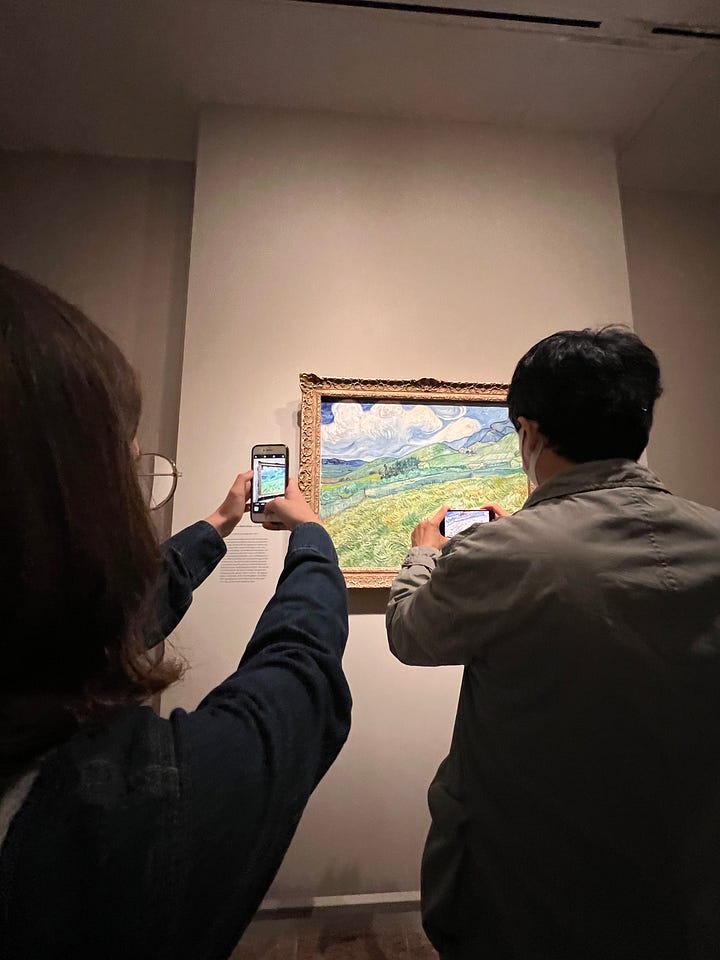
Many a New Yorker has found themselves entranced by The Starry Night at the Museum of Modern Art, or dazzled within the vibrant swirls of The Immersive Van Gogh Exhibit. Yet, Van Gogh's Cypresses presents something altogether different, something more intimate and contemplative.
This particular exhibition, the first of its kind to shine a spotlight solely on Vincent Van Gogh's arboreal fascination, brings together 40 of his works, all fixated on the cypress tree. The exhibit isn't merely a display; it's an exploration of obsession. Through the carefully curated collection, one begins to peer into the artist's mind, witnessing the repeated sketches of cypresses that filled his thoughts for months on end.
Van Gogh's relationship with these cypress trees is one for the ages, a partnership that has resonated through the annals of art history.
As he confided in a letter, "The cypresses still preoccupy me, I’d like to do something with them like the canvases of the sunflowers because it astonishes me that no one has yet done them as I see them. It’s beautiful as regards lines and proportions, like an Egyptian obelisk. And the green has such a distinguished quality."
In the textured greens and haunting darks of his paintings, Van Gogh's obsession with these trees blooms into a turbulent beauty. The looping brushwork in his depiction of the cypresses mirrors the way thoughts can loop within the mind, a continuous and unending fascination. It's not just simple foliage in his eyes; they are a reflection, a symbol, perhaps even a manifestation of his emotional landscape.
Every brushstroke, every interpretation and reinterpretation of the subject, is a testament to this fascination. The cypresses were his unwavering muse, his consistent connection in a world swirling with uncertainty. They were, in essence, a part of him, forever captured on canvas.
Van Gogh and his creative refuge
Vincent van Gogh's relationship with cypress trees was more than a mere artistic pursuit; it was deeply intertwined with his mental well-being. During his time in the Provençal town of Arles and later at the Saint-Paul-de-Mausole asylum in Saint-Rémy-de-Provence, Van Gogh battled intense emotional turmoil. It was in this period, particularly in June 1889, that he began his iconic paintings of the flamelike trees.
The cypresses, with their towering and unyielding forms, might have represented a stability and continuity that he was seeking in his own mind. His obsession with these trees was not merely a fascination with their physical form but rather a therapeutic endeavor, a way to grasp and understand his own mental state. The very act of painting became a form of self-exploration and self-expression, allowing him to delve into his own psyche and possibly find solace in his relentless repetition of the subject.
Van Gogh's cypress paintings offer a glimpse into the soul of a troubled genius. They are a testament to an artist's struggle with mental health and his ability to translate that struggle into art. In the lines, shades, and shapes of the cypresses, we see not just trees, but the contours of Van Gogh's inner world, a mirror to his emotional turbulence. The beauty and complexity of these paintings serve as a poignant reminder of the connection between creativity and mental well-being, and how art can become both a refuge and a revelation.
A somber reflection - The exhibit's treatment of Van Gogh's mental struggles was, for me, a point of subtle grace. It acknowledged the complexities of his inner world without delving into the more graphic aspects of his turmoil. This discretion is something to be admired; it stands as a respectful nod to the private battles that all individuals, artists and public figures alike, endure. It's a gentle reminder that while the works of a creator might be on public display, the shadows of their soul deserve a measure of privacy and contemplation. In this way, the exhibit pays homage not only to Van Gogh's artistic brilliance but also to his humanity, delicately honoring both his genius and his fragility.
Katya Cares and her creative refuge
In my own moments of introspection, I've considered how a tangible artistic obsession might fill the caverns of my mind, replacing the relentless echoes of negativity with something radiant and consuming.
Whether it's a cough here or a sneeze there, or the looming specter of a worst-case scenario, my thoughts are haunted anyway. But what if there's a better thing to focus on and preoccupy my mind? I imagine using a brush and palette to create art, with a subject that speaks to me; it might become a balm for my soul.
This is where art becomes more than a display of beauty; it turns into a soothing process. In the deliberate strokes and the patient layering of colors, there's a therapeutic connection. It's a meditation that occupies the hands, stills the mind, and brings tranquility.
Van Gogh's connection to his cypresses might have been more than an artistic obsession; it was a comforting routine that possibly brought solace to his troubled mind. Could this passion have extended his life?
The act of creation isn't merely a diversion; it's a lifeline, a calming guide through the stormy seas of our inner worlds, leading many to peace and fulfillment.
Katya Cares and her creative quandary
Since visiting the exhibit, I've found myself, swathed in all the self-centeredness one might expect from our species, reflecting on my own art. It's not just Van Gogh's vivid post-impressionist style that catches my eye; it's the way he dances with colors. Bright colors. I too love bright colors. No matter the subject, Van Gogh's art stirs emotion within me, simply by virtue of those hues.
Now, if we're talking differences between my work and his, it isn't merely the, shall we say, 'talentery' behind it. Yes, I jest, but my real conundrum is that I'm often left adrift, brush in hand, wondering what my subject should be. What would be my cypress trees, the muse I would return to again and again?
The question is a shadow on my canvas: If someone were to delve into the recesses of my mind, what would they unearth?
Unlike Van Gogh, whose obsession with cypresses became a tangible expression of his artistic spirit, I meander in a more elusive pursuit.
My creative landscape is a labyrinth, void of that singular, insistent obsession. I don't draw anything with the same compulsive recurrence. I don’t see anything that intimately. Van Gogh himself once put it beautifully, 'To find the real character of things here, you have to look at them and paint them for a very long time.'
Perhaps my search is less of a sprint and more of a meandering path, similar to my wanderings through museums. It leads me to discover an object or theme that will set my artistic soul ablaze, just as the cypresses did for Van Gogh.
Will AI replace artists?
Reflecting on my experience with Van Gogh's work, I can't help but think about the profound difference between human creativity and artificial intelligence. Sure, AI can replicate the strokes and colors of Van Gogh's paintings, but can it really capture the obsession, the emotional turmoil, the very essence that made his art come alive?
What would AI obsess over? 10% of the entire internet? Now there's a fixation hard to grasp – even Van Gogh might have had trouble with that one!
Peeking into his creative process, observing him attempt the same subject repeatedly, and reading his letters created an intimate connection between me and Van Gogh's art. The allure of art isn't only in the finished product; it's in the story, the journey, and the shared humanity that algorithms can never replicate. This is what attracts us to art, what resonates with our souls, and why Van Gogh remains irreplaceable. It's not about the product; it's about the personal connection, the emotion, and the genuine heart behind each stroke.
Obsession
In the realm of creative expression, obsession binds the artist to their work. Van Gogh's obsession with his cypresses was a manifestation of his connection to his surroundings, a tangible symbol of his internal struggles and triumphs.
Today, while AI can emulate artistic techniques and even generate ideas, it cannot replicate the unique obsession that often infuses art with life. This obsession, personal and tied to our physical world, often leads to more profound stories and resonant results. It turns art into a living entity that echoes the creator's soul.
As we wonder the Van Gogh’s Cypresses exhibit, we don't merely see paintings; we feel the intensity of his obsession.
In our artistic journeys, what will be our cypress tree, our own obsession that gives our work depth and meaning? Through understanding this, we may discover not only our artistic voice but also a piece of our very essence. Perhaps it's this authentic connection and obsession that transforms a simple image into a resonant tale of humanity, where art and obsession become one.

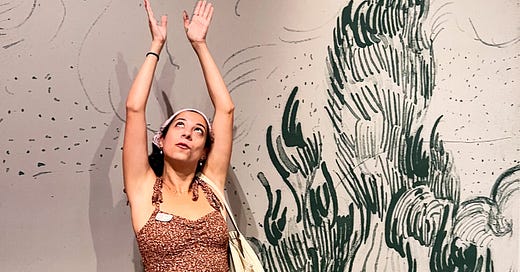



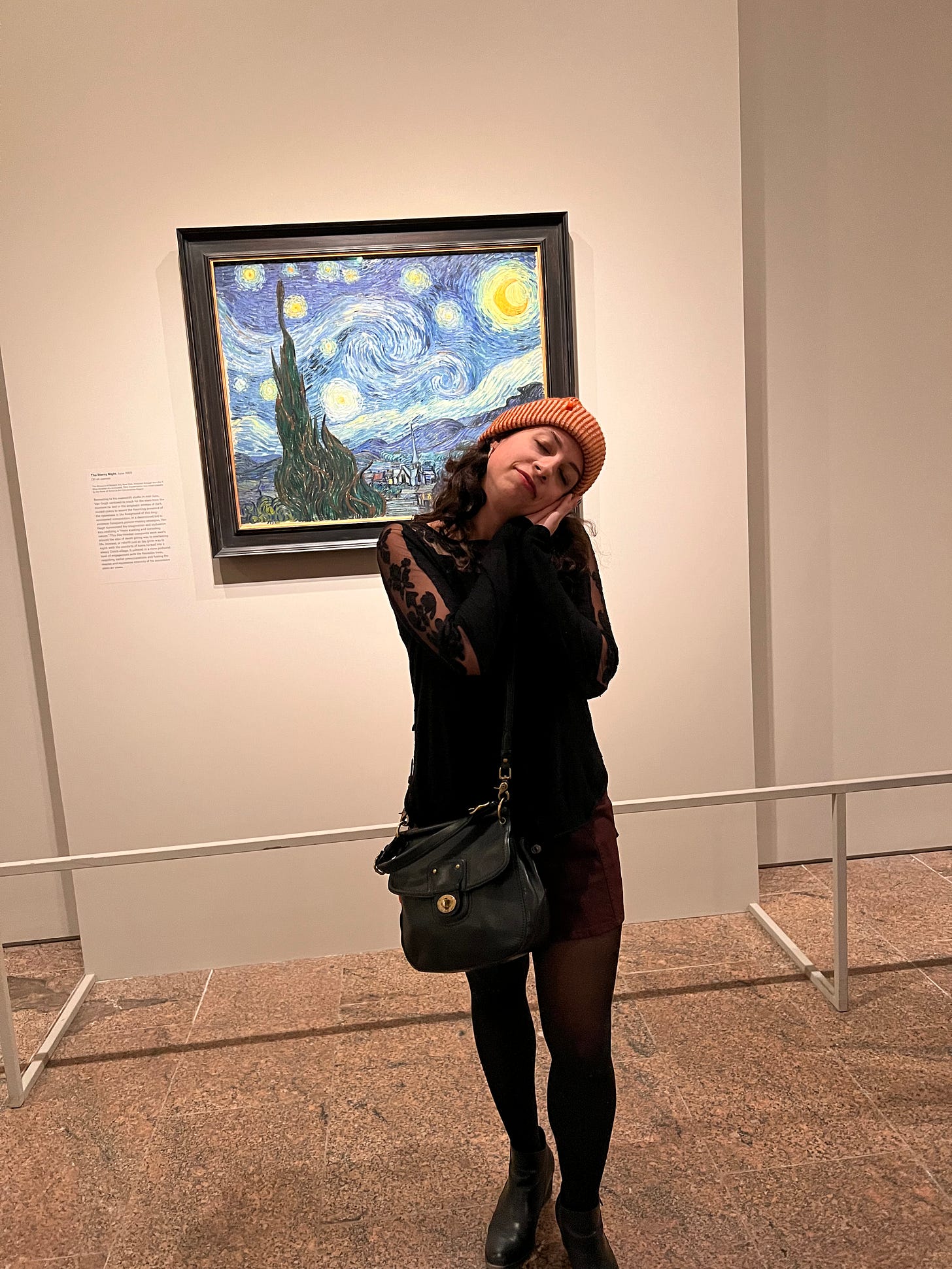
I enjoyed this post so much! You talk a lot about the direction of your drawings, and whether there is one, but you don't mention the art that is your writing! Each piece is written in a different style, often seemingly resembling the emotions that you feel that week. You so vulnerably explore and share your thoughts on themes ranging from academics to art, and to your own personal experiences of simply existing and being on this earth. Similarly to how you describe your drawings, your writing explores so many topics so thoughtfully - perhaps your skill isn't to fixate on one subject, but rather to be able to explore and think deeply about so many!
Also, I visited the Saint-Paul-de-Mausole asylum in Arles many years ago...GO, GO, GO! It's breathtaking and the landscape begs to be explored and romanticized. Definitely explains his obsession! To see is to believe, as they say!